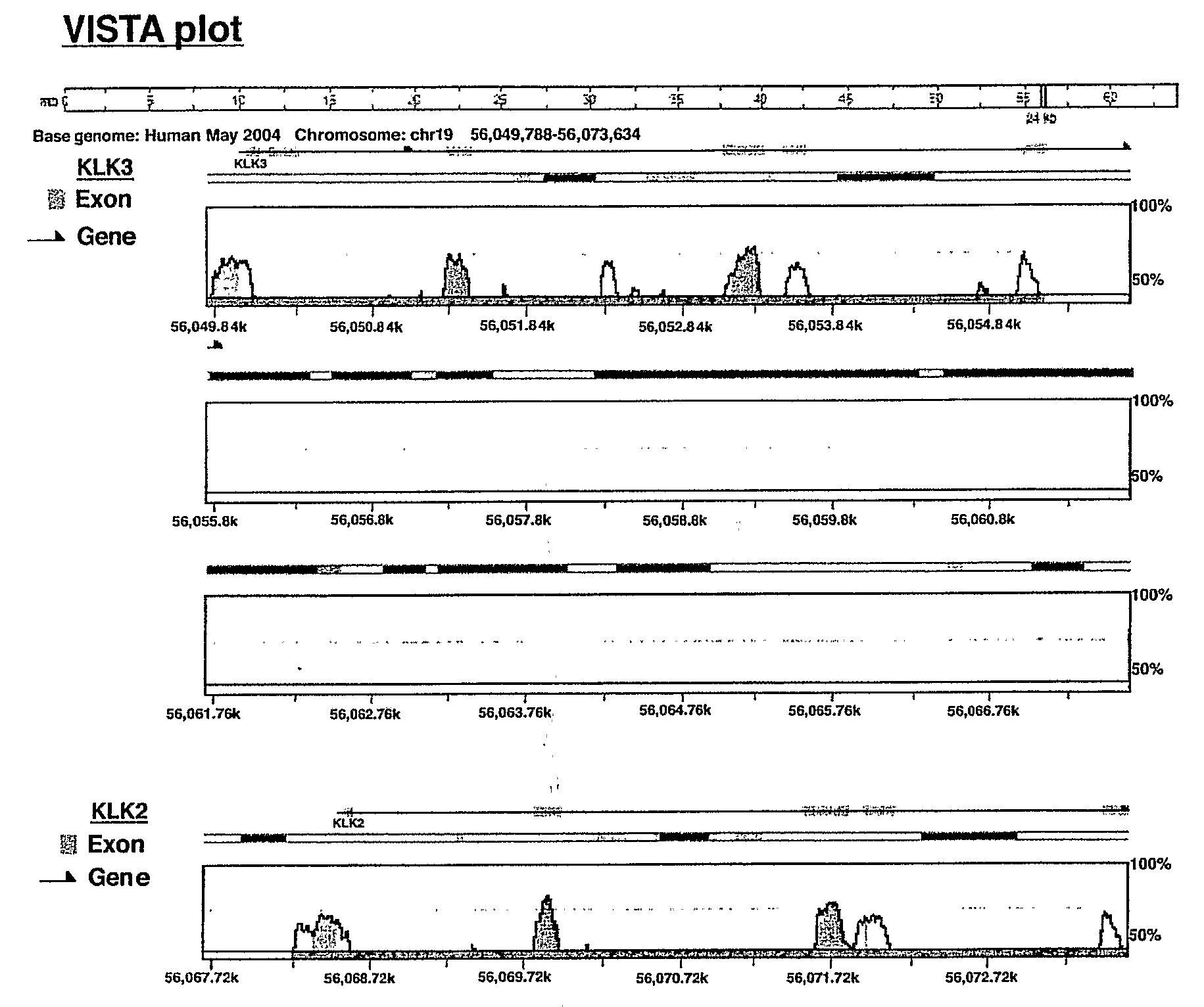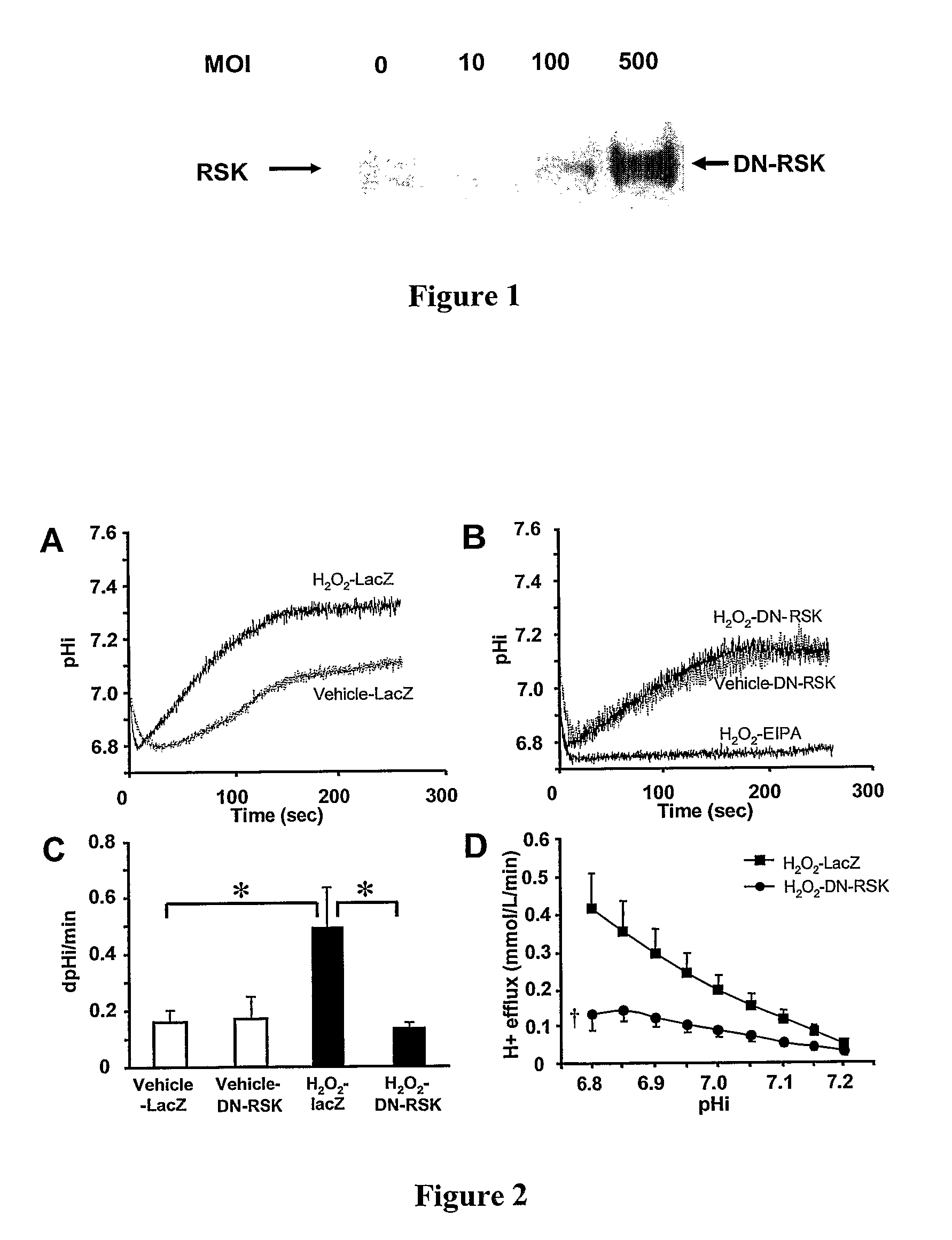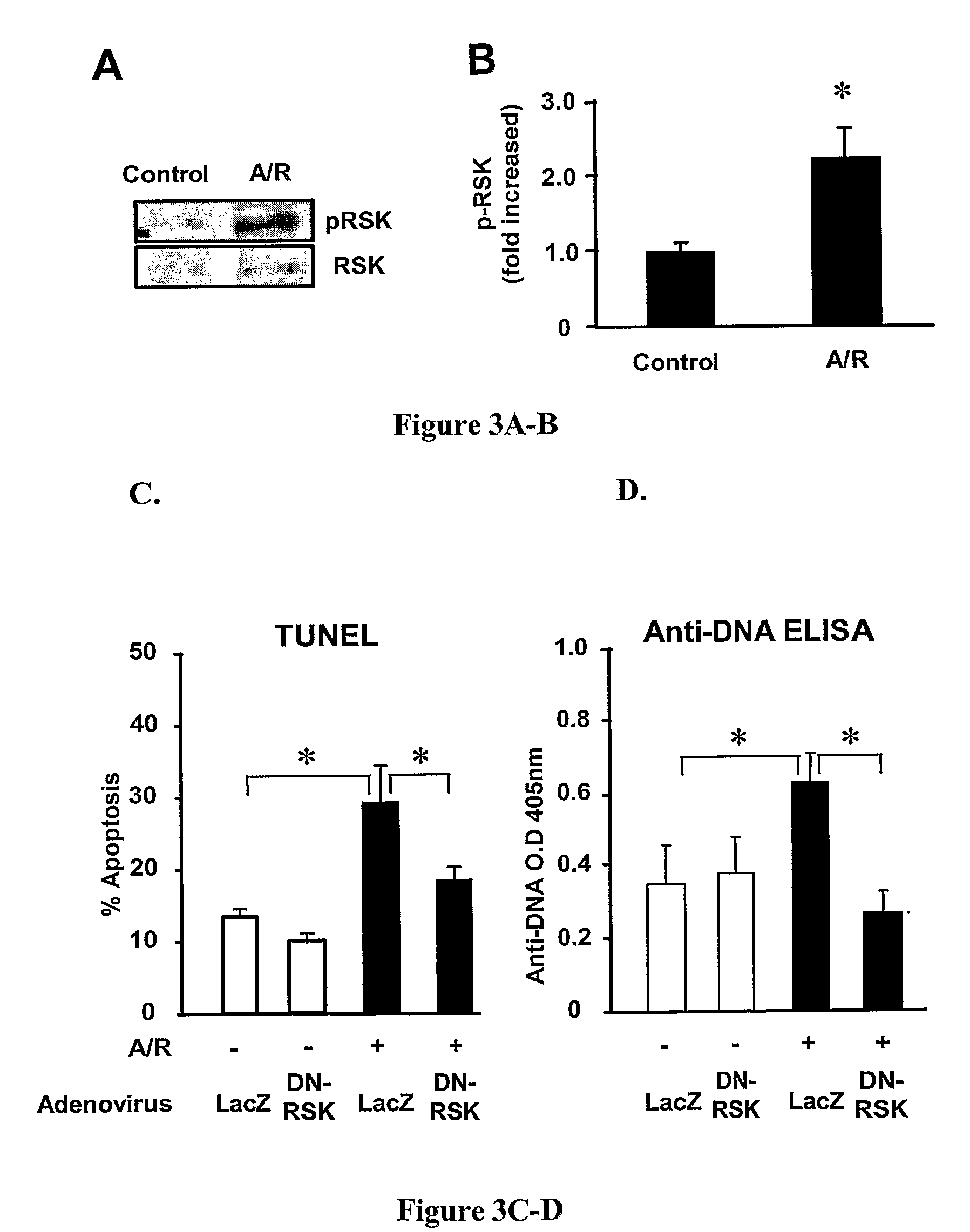Transgenic Non-Human Animal Models of Ischemia-Reperfusion Injury and Uses Thereof
a technology of ischemia-reperfusion injury and transgenic non-human animals, which is applied in the field of transgenic non-human animal models of ischemic reperfusion damage, can solve the problems of increased postoperative creatine and increased mortality, and achieve the effect of preventing functional derangemen
- Summary
- Abstract
- Description
- Claims
- Application Information
AI Technical Summary
Benefits of technology
Problems solved by technology
Method used
Image
Examples
example 1
Generation of Cardiac Specific DN-RSK-Tg Mice
[0133]Rat RSK (SEQ ID NO: 1; GeneBank Acc. No: NM—031107, which is hereby incorporated by reference in its entirety) was mutated to K94A / K447A to create a DN-RSK gene (SEQ ID NO: 2) encoding a kinase dead protein (Bjorbaek et al., “Divergent Functional Roles for p90rsk Kinase Domains,”J Biol Chem 270:18848-52 (1995), which is hereby incorporated by reference in its entirety) using the QuikChange site-directed mutagenesis kit (STRATAGENE, La Jolla, Calif.) (Dalby et al., “Identification of Regulatory Phosphorylation Sites in Mitogen-Activated Protein Kinase (MAPK)-Activated Protein Kinase-1a / p90rsk that are Inducible by MAPK,” J Biol Chem 273:1496-1505 (1998), which is hereby incorporated by reference in its entirety). The DN-RSK gene was cloned into a vector under the direction of the α-MHC (myosin heavy chain promoter region, Accession No. U71441) to allow for cardiac-specific (cardiomyocyte) expression (Gulick et al., “Isolation and Cha...
example 2
NHE1 Activity in Neonatal Rat Cardiomyocytes
[0136]To prove the essential role of RSK as a regulator of NHEL activity in the heart, neonatal rat cardiomyocytes were transduced with Ad.DN-RSK and Ad.LacZ (500 MOI), and NHE1 activity was measured, as shown in FIG. 1 and FIGS. 2A-D. In response to 100 μM H2O2, NHE1 activity increased 3-fold in LacZ expressing cardiomyocytes (0.16±0.02 to 0.49±0.13 pHi / min), as shown in FIG. 2A. In contrast, in cardiomyocytes expressing DN-RSK, H2O2 did not significantly stimulate NHE1 (0.17±0.08 to 0.14±0.03 pHi / min), as shown in FIG. 2B. The difference in rate of pHi recovery was highly significant (p<0.05), as shown in as shown in FIGS. 2C-D.
[0137]To show the difference in pHi recovery when NHE1 was inhibited by DN-RSK as compared to pharmacologic antagonism of transport, the potent NHE1 inhibitor EIPA was used, as shown in FIG. 2B. Pretreatment with 5 μM EIPA decreased pHi recovery to a much greater extent than DN-RSK (0.012±0.0001 pHi / min) significa...
example 3
Effect of DN-RSK and WT-RSK on Cardiomyocyte Cell Death
[0138]To provide further evidence for the importance of RSK-mediated activation of NHE1, the effect of altering RSK activity a study was carried out on cardiomyocyte apoptosis induced by anoxia for 12 hr followed by reoxygenation for varying times (A / R). Phosphorylation of endogenous RSK was significantly increased (2.3±0.4-fold, p<0.05) after A / R (12 hr / 10 min), as shown in FIGS. 3A-B.
[0139]Next, the effect of overexpressing Ad.DN-RSK on rat neonatal cardiomyocyte death induced by A / R was studied. Cells were treated with A / R (12 br / 24 hr). A / R significantly increased both TUNEL positive cells (10±2.8% to 32±3.1%, p<0.01) and DNA fragmentation (0.18±0.01 to 0.78±0.09, p<0.01), as shown in (FIGS. 3C-D). Transduction with Ad.LacZ or Ad.DN-RSK alone had no effect on apoptosis in the absence of A / R. However, DN-RSK transduced cardiomyocytes exhibited significantly decreased apoptosis compared to LacZ transduced cells (A / R Ad.LacZ; T...
PUM
| Property | Measurement | Unit |
|---|---|---|
| pH | aaaaa | aaaaa |
| pH | aaaaa | aaaaa |
| thick | aaaaa | aaaaa |
Abstract
Description
Claims
Application Information
 Login to View More
Login to View More - R&D
- Intellectual Property
- Life Sciences
- Materials
- Tech Scout
- Unparalleled Data Quality
- Higher Quality Content
- 60% Fewer Hallucinations
Browse by: Latest US Patents, China's latest patents, Technical Efficacy Thesaurus, Application Domain, Technology Topic, Popular Technical Reports.
© 2025 PatSnap. All rights reserved.Legal|Privacy policy|Modern Slavery Act Transparency Statement|Sitemap|About US| Contact US: help@patsnap.com



